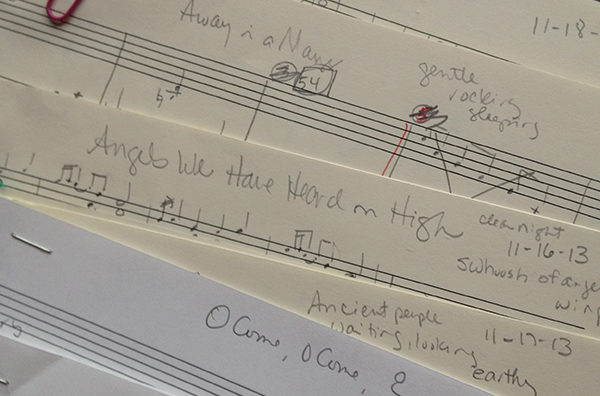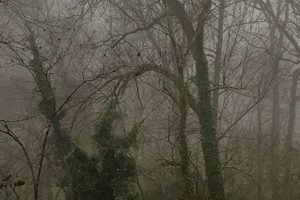The Making of Nowell! Carols of Christmas Joy
Piano and Instrumental arrangements by Peg Thompson
I wish we could put up some of the Christmas spirit in jars
and open a jar of it every month.
— Harlan Miller (1897-1968) newspaper columnist, editor, and magazine feature writer
As a young person I could not wait until Thanksgiving arrived each year. That signaled the day I would pull out all my Christmas carol books and play through them every day. I would arrange the music into a program and imagine I was performing in some great Christmas concert.
Having been a church musician for over forty years, one of my great joys has been to design programs for Advent and Christmas. In November of 2013 I decided to make a Christmas CD. Through these arrangements I wanted to explore and express the emotional passion found in these lovely carols—from the quiet awe, a longing and hope for freedom, the tenderness of a mother’s love, profound serenity, deep inner joy, the miracle of birth (both physical with Jesus and metaphorical with our own rebirth) to an uninhibited, joyful desire to dance!

I was inspired by images and meanings in the texts and I let the melody of each carol guide me. As I sat at the piano, intuitively I heard counter melodies and sonorities that were evocative of the tunes. The instrumentation for each track varies from solo piano to Renaissance flavored settings using harpsichord or organ with various percussion instruments and recorder.
The entire process was fulfilling as well as fun! I came up with the idea for the cover design and Gary created the final version. While waiting for him to do all the editing and mixing, I used my nervous energy to create videos for three of the songs. I wrote a brief look at the inspiration behind each arrangement. Then I researched and wrote a few sentences about the history of of each carol.
Whenever I wonder if I can accomplish anything—I pull out the CD and listen. It is difficult being a composer when you are dependent on others for performances. If there are no performances, the music remains as merely squiggles on a page. Music only comes alive through being performed and heard. That experience completes the creative circle.
A brief look at the inspiration behind the arrangements—
1. Angels We Have Heard on High (French Carol)
The swoosh of the angels wings and the sound of angels singing—what a glorious sight and sound! The Gospel according to Luke records the first line of the angels’ song: “Gloria in Excelsis Deo.” —Glory to God in the Highest! The melismatic sequence on the word Gloria reflects the joyous, yet elegant image of the angels.
2. The Sussex Carol (English Carol)
All the townspeople gather to celebrate the good news of Christ’s birth by dancing, singing, and making merry!
3. Brightest and Best (Star in the East) (MORNING STAR; The Southern Harmony)
The bright mood of the Sacred Harp tune brought to mind the sound of a music box.
4. O Come, O Come, Emmanuel (10th century Plainsong)
Emmanuel (“God with us”). This arrangement expresses our waiting and longing for the redemptive grace of God through Jesus. The music represents through sound the transcendent mystery of God becoming human.
5. Shepherds, Shake Off Your Drowsy Sleep (French Folk Melody)
The simple dance-like character of the old French melody is reflected in this joyful arrangement.
6. Away in a Manger (William J. Kirkpatrick, 1895)
Simple, calm music depicts the sight of the innocent baby asleep on the hay.
7. Masters in This Hall (Marin Marais, 1706)
The earthy, common-folk character of this carol evokes a scene of the people gathering to celebrate at a large castle or great hall of upper-class folk.
8. O Come, All Ye Faithful (John Francis Wade, ca. 1743)
O come, all ye faithful—the music expresses the awe one must feel in setting out to “see” God incarnate.
9. Christmas Lullaby (original composition by Peg Thompson)
The simple, unadorned music reflects the humble birth of Jesus.
10. Silent Night (Franz Xavier Gruber, 1818)
In nativity scenes, Medieval and Renaissance painters commonly used yellow hues against the dark of the night. Some examples are “Adoration of the Shepherds” by Gerard van Honthorset, 1622; “The Nativity” by Georges de La Tour, 1645; and “The Adoration of the Shepherds” by Philippe de Champaigne, c. 1628. The warm, tender glow of light (metaphorically if not literally) surrounding Jesus’ birth was the inspiration for this music. I imagine the aura of light as being a peaceful, stillness that Jesus brings to the world . . . “radiant beams from thy holy face . . .”
11. Go, Tell It On the Mountain (African American Spiritual)
The African American jazz idiom inspired this arrangement for piano. This track is dedicated to vocal coach/jazz pianist, teacher, and friend Ron Browning.
12. In the Bleak Midwinter (Gustav Holst, 1906)
The sparkling, shimmering light on a cold, morning snow . . . the earth is frozen but there is the hope of spring deep inside . . . the earth awaits its rebirth through the arrival of spring . . . just as we are reborn through the coming of Christ.
13. He Is Born (Traditional French)
The jaunty, cheerful melody inspired a spirited Renaissance-like arrangement.
14. Of the Father’s Love Begotten (Medieval Plainchant Melody)
This simple, plaintive melody lends itself to a setting pondering the mystery of God’s creation of the world. God, the Alpha and Omega, the source of everything . . .
A brief look at the history of the carols—

1. Angels We Have Heard on High (GLORIA) (French Carol)
This traditional French carol was originally titled “Les anges dans nos campagnes.” No printed source has been found earlier than 1842. However, it is generally believed that it is an 18th century nöel, perhaps from Lorraine or Provence and the melody could very well be older. The text was translated into English in 1869 by James Chadwick.
Angels we have heard on high
Sweetly singing o’er the plains,
And the mountains in reply
Echoing their joyous strains.
Gloria, in excelsis Deo!
Gloria, in excelsis Deo!
2. The Sussex Carol (SUSSEX CAROL) (English Carol)
The words were first published in 1684 by Irish Bishop, Luke Wadding. The tune is a traditional English tune that was heard and transcribed by Cecil Sharp and also by Ralph Vaughan Williams. The bouncy, dance-like character of this carol lends itself to a festive and joyous setting.
On Christmas night all Christians sing
to hear the news the angels bring;
on Christmas night all Christians sing
to hear the news the angels bring:
news of great joy, news of great mirth,
news of our merciful King’s birth.
3. Star in the East (MORNING STAR) (The Southern Harmony)
This carol is also known as, Brightest and Best. The Southern Harmony was one of the early shape-note collections and was first published in 1835. Bishop Reginald Heber (1783-1826), a prolific Anglican hymn writer, wrote the words.
Brightest and best of the sons of the morning;
Dawn on our darkness and lend us thine aid;
Star in the East, the horizon adorning,
Guide where our infant Redeemer is laid.
4. O Come, O Come, Emmanuel (VENI EMMANUEL) (Plainsong)
The antiphon Veni, veni, Emmanuel is from between the 8th and 12th centuries. We know it as O Come, O Come, Emmanuel through the translation of John Mason Neale and Henry Sloane Coffin in the mid-19th century. Emmanuel means “God with us.”
O come, O come, Emmanuel,
and ransom captive Israel,
that mourns in lonely exile here
until the Son of God appear.
Rejoice! Rejoice! Emmanuel,
shall come to thee O Israel!
5. Shepherds, Shake Off Your Drowsy Sleep (BESANÇON) (French Folk Melody)
The tune, BESANÇON, was included in La Clef des chansonniers (1717) among the tunes ‘more than a century old.’ It first appeared in 1871 as the setting for “Shepherds, Shake Off Your Drowsy Sleep.” Eleanor Farjeon (1881-1965) wrote the text “People, Look East” for this delightful melody.
Shepherds! Shake off your drowsy sleep,
Rise and leave your silly sheep;
Angels from Heav’n around loud singing,
Tidings of great joy are bringing,
Shepherds! The chorus come and swell!
Sing Nowell, O sing Nowell!
6. Away in a Manger (CRADLE SONG) (William J. Kirkpatrick, 1895)
William James Kirkpatrick (1838-1921) was an American hymn writer of Irish birth. He was a prolific writer and this lesser-known tune for this popular text is refreshing and lovely.
Away in a manger, no crib for a bed,
The little Lord Jesus lay down His sweet head.
The stars in the bright sky looked down where He lay,
The little Lord Jesus asleep on the hay.
7. Masters in This Hall (Marin Marais, 1706)
French composer, Marin Marais, composed this dance tune for his opera Alcyone in 1706. The words were written about 1860 by William Morris. William Morris (1834-1896) was an English textile designer, writer, artist and was associated with the Pre-Raphaelite Brotherhood and the English Arts and Crafts Movement. The ancient feel of the tune embodies a folk-like common character. Morris’ romanticism and socialist beliefs are reflected in the lines about the poor bringing news of Christ’s birth to the “Masters in this Hall.”
Masters in this hall,
Hear ye news today
Brought from over sea,
And ever I you pray:
Nowell! Nowell! Nowell!
Nowell sing we clear!
Holpen are all folk on earth,
Born is God’s son so dear:
Nowell! Nowell! Nowell!
Nowell sing we loud!
God today hath poor folk raised
And cast a-down the proud.
8. O Come, All Ye Faithful (ADESTE FIDELES) (John Francis Wade, c. 1743)
John Francis Wade, a Catholic layman, was an English hymnist and is often credited with composing this hymn. He fled the Jacobite rebellion in 1745 and settled in France where he taught music. He is also well-known for his production of a large series of Catholic plainchant books. Wade perfected his calligraphy, illumination, and the copying of plainchant music for worship.
Yea, Lord, we greet Thee, born this happy morning;
Jesus, to Thee be glory given;
Word of the Father, now in flesh appearing.
O come, let us adore Him,O come, let us adore Him,
O come, let us adore Him,
Christ the Lord.
9. Christmas Lullaby (original composition by Peg Thompson)
This little lullaby is from a collection of easy Christmas music for 2-3 octave handbells. (Handbells Are a Handful of Fun! Christmas Music Volume 2)
10. Silent Night (STILLE NACHT) (Franz Xaver Gruber, 1818)
Organists in Austria and Bavaria would often compose folk-like songs each year for the Christmas Eve midnight mass. They were inspired by the cradle and shepherd songs of the medieval tradition. Stille Nacht follows this custom. Joseph Mohr wrote the text in about 1816. Franz Gruber set the words to music in 1818.
Silent night, holy night,
Son of God, love’s pure light
Radiant beams from Thy holy face,
With the dawn of redeeming grace,
Jesus, Lord, at Thy birth,
Jesus, Lord, at Thy birth.
11. Go, Tell It On the Mountain (GO TELL IT) (African American Spiritual)
This 19th century African American Spiritual was published in Folk Songs of the American Negro by John Wesley Work, Jr. in 1907.
Go, tell it on the mountain,
Over the hills and everywhere
Go, tell it on the mountain,
That Jesus Christ is born.
12. In the Bleak Midwinter (CRANHAM) (Gustav Holst, 1906)
The words of this carol are based on a poem by English poet, Christina Rossetti from about 1872. Gustav Holst set the words to music in 1906. The words describe England’s winter weather rather than Palestine’s weather. By using familiar surroundings, Rossetti sought to make the nativity personal.
In the bleak midwinter, frosty wind made moan,
Earth stood hard as iron, water like a stone;
Snow had fallen, snow on snow, snow on snow,
In the bleak midwinter, long ago.
13. He Is Born (IL EST NE) (Traditional French)
The text was first published in 1875 or 1876 by Dom G. Legeay. The earliest publication of the tune was mid-nineteenth century. In that publication it was called “Ancien air de chasse.”
He is born, the divine Christ child.
Play the oboe and bagpipes merrily.
He is born, the divine Christ child.
Sing we all of the Saviour’s birth.
14. Of the Father’s Love Begotten (DIVINUM MYSTERIUM) (Medieval Plainchant Melody)
The earliest version of this plainchant melody appeared in the 10th century. The Spanish poet, Prudentius (d. 413), wrote the words that we now sing to the plainchant.
Of the Father’s love begotten, ere the worlds began to be,
He is Alpha and Omega, He the source, the ending He,
Of the things that are, that have been,
And that future years shall see, evermore and evermore!
Source for historical information:
The New Oxford Book of Carols
Edited by Hugh Keyte and Andrew Parrott
Oxford University Press, 1992










Leave a Reply
Your email is safe with us.